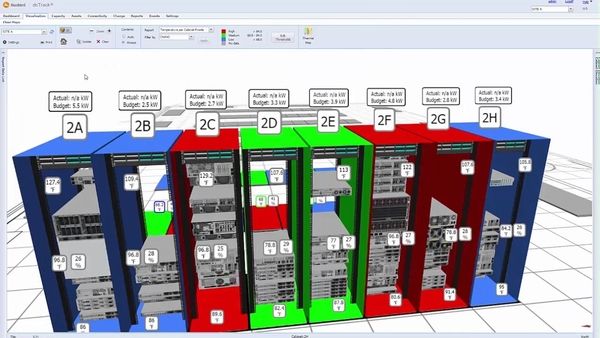
Data Centers as Depicted by Hollywood
June 19, 2019
How Augmented Reality Is Actually Transforming Data Center Management
June 25, 2019Industries are looking to automate processes to improve efficiency and enhance the end-user experience. To do so, industries are looking to technologies like Artificial Intelligence and Internet of Things.
Many industries are already experimenting with AI now, and IoT is a relatively older concept. In other words, IoT has already become a part of even more industries.
In this article, we explore the adoption rate of AI and IoT worldwide, what are we talking about in terms of data generation, and what kind of storage solutions businesses need to effectively store, manage, and control the big data of AI and IoT.
Organizations Worldwide Integrate Artificial Intelligence & Internet of Things

Artificial Intelligence (AI) is helping organizations and industries automate and decentralize processes while removing human error. This ability of AI to work on its own and accomplish tasks with little to no mistakes is what makes it appealing for all industries.
Plenty of industries are already integrating AI in one way or the other, and many are planning to follow suit.
The Internet of Things (IoT) is a slightly older concept than AI and is equally essential for organizations and industries. IoT enables the different systems within an organization to communicate with one another to perform specific tasks, laying the foundations of smart networks, offices, and smart cities.
Both AI and IoT have found a unique and irreplaceable place in the digital business model of today. Moreover, businesses worldwide are investing in both technologies.
AI Adoption Worldwide
Gartner’s survey shows that 37 percent of organizations have already implemented AI in some form.
Considering the benefit and application of AI, it is highly likely that this adoption rate will continue to grow in the future.
IoT Adoption Worldwide
Similarly, IoT spending was estimated at around $151B in 2018. Also, according to IDC, spending on IoT is expected to reach $1.2T in 2022.
Safe to say, organizations from all industries and domestic users are expected to invest in IoT aggressively.
Verily, the integration of AI and IoT makes life easy for organizations and end-users alike. However, as with all great things, there’s a catch: AI and IoT generate big data and large data lakes.
Digital Footprint of AI & IoT Technologies: Big Data & Large Data Lakes

AI depends on data processing, analysis, and usage. IoT, to accomplish tasks and communicate with connected devices, generates large chunks of data.
Both technologies rely on data and generate many data that combine into giant complex pools that are difficult to manage and almost impossible to control. This makes it very difficult for organizations to use them to their fullest potential.
Regardless of the application/use case, AI is as efficient as the amount and quality of data that it’s fed and its processes. The higher the complexity of the tasks, the more data it will need to store, and process, and the bigger the data lake will be.
That may be a downside, but the silver lining here is that because of this ability, AI is already contributing to healthcare, finance, research, and many other industries. Therefore, these extensive bits of data are “necessary evil.”
How Much Data Does IoT Generate?
IoT relies on the number of devices connected and the complexity of tasks being assigned. This is similar in principle to AI.
Cisco estimates that by the end of 2019, IoT will generate more than 500ZBs (Zettabytes) of data per annum.
In light of this information, it’s clear that organizations looking to integrate or already working with both AI and IoT will find themselves with large data lakes.
These data lakes, in turn, will need storage media capable enough to store, retain, manage, and control them effectively. This implies that traditional storage infrastructures will not cut it.
How to Effectively Handle Big Data & Large Data Lakes?
Large volumes of data need highly scalable, robust, and redundant storage infrastructure. To effectively store, retain, manage, and control large data lakes, the data storage solution has to have the following attributes:
- High Scalability
- High Availability & Redundancy
- Hybrid Storage – On-premises Cloud Native Appliance
- Simplified Management
- Automated Storage Tiering
Let’s briefly go over each of these attributes:
High Scalability
We’re talking about the combination of AI and IoT; hence, this translates to GBs of data that grows into TBs and then PBs. The designated storage solution has to be equally scalable. It should be able to start from terabytes and should be scalable to petabytes.
Most organizations cannot tolerate disruption even when they need to add more performance and storage capacity. Thus this ability to scale needs to be dynamic and disruption-free.
High Availability & Redundancy

As mentioned earlier, unavailability or disruption is not an option for most industries.
Healthcare service providers cannot wait for the availability of data, and it can mean life or death for someone. Similarly, end users are now developing the habit of quick processing and high performance. Businesses have to evolve similarly. That is why high availability and redundancy is crucial.
The storage solution needs to be redundant so that it’s fault-tolerant. It should be able to continue operating even in the event of a hardware failure. In other words, the storage system shouldn’t have a single point-of-failure.
Similarly, it shouldn’t rely on one power supply. It should have redundant power supplies.
It should also have RAID and erasure coding so that even in the event of a drive failure, data remains seamlessly available.
Hybrid Storage – On-premises Cloud-Native Data Storage
Cloud plays a vital role in molding data storage so that it’s more suitable for big data and large data lakes. Cloud is scalable, cost-effective, and helps take the load-off of on-premises storage infrastructure.
Not to mention, cloud-native appliances offer greater accessibility and data mobility. This, in turn, compliments large corporate setups and research environments.
Cloud is also beneficial for archival purposes. As data gets old, it continues to consume space while giving reduced value. By moving this older data to the cloud, IT environments can dedicate high-end storage infrastructure for frequently accessed (hot tier) data. Consequently improving storage performance and optimizing data storage.
Simplified Management
Even with the “right” storage infrastructure, and the right features, it means little to nothing if it’s not easily manageable.
If your IT staff is struggling with the management and control of large volumes of data and it’s taking their time, it’s taking training hours and is still inefficient then it’ll have the opposite effect. That’s the importance of simplified management.
Data storage, especially for large data pools, has to be easily manageable. Management depends on the software you choose to use. There are several third party software that enables businesses to manage all storage resources using a single management interface.
Automated Storage Tiering
Automated storage tiering helps simplify management, but it deserves to be mentioned separately.
An ideal storage infrastructure should be able to support hybrid installations such as combinations of enterprise hard drives (SAS) and flash (SSDs), along with the integration of the cloud. This creates different storage tiers with various cases of use within a single storage solution.
By setting up automated storage tiering, you can move data between storage tiers and optimize data storage while reducing the cost implications.
Automated data transfers increase the efficiency of data storage and help IT administrators to focus on other tasks. This is why automated storage tiering is a must have for organizations looking to work with the big data of AI and IoT technologies.
What else can organizations do to prepare their data centers for big data and large data lakes? We’ve written about the five best practices in data center design to help with that.
Conclusion
Artificial Intelligence and Internet of Things are essential pieces of the puzzle for many industries and a way to move forward.
The data lake generates by the culmination of AI and IoT requires dedicated, high performance, redundant and scalable data storage solutions. It’s essential that these data storage solutions are robust and easily manageable so that they can complement operations and contribute to productivity and efficiency.
The only way for industries to move forward with AI and IoT is to choose the best storage solution for the big data generated by both technologies.

